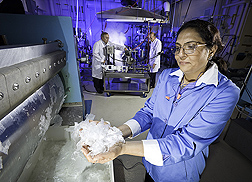Cutting the Fat—and Calories—
in a Childhood Favorite
Children’s birthday celebrations might soon be even happier, thanks to research that’s trimming the fat and calories from a traditional favorite—cake and frosting. Any subtracting of fat, and its calories, from foods that kids crave is a plus, in light of the nation’s epidemic of childhood obesity.
At the ARS National Center for Agricultural Utilization Research in Peoria, Illinois, food technologist Mukti Singh is working to slim down the fat and calories of cake mixes. She’s doing that by formulating the mixes with FANTESK—microdroplets of trans-fat-free cooking oil, encapsulated in cornstarch or wheat flour.
In experiments at her laboratory, Singh has found that low-fat cake mixes made with FANTESK don’t need added oil. The mixes yield cakes that have better texture and a higher volume—improvements that even the most undiscerning young palates can readily appreciate.
What’s more, the lower fat frostings that she and Peoria chemical engineer Jeffrey Byars are creating with FANTESK have the smooth texture and spreadability of buttercream favorites, yet contain up to 50 percent less fat.
Meanwhile, fruit is the focus of two healthful snacks from scientists based in California—the state that grows more fresh produce than any other.
The all-natural, junior-size fruit bars that ARS food technologist Tara H. McHugh, at the ARS Western Regional Research Center in Albany, near San Francisco, and retired colleague Charles Huxsoll have developed fit perfectly in a child’s lunch sack or backpack. The chewy bars each provide the equivalent of about one serving of fruit and are available in an array of appetizing flavors, including apple, pear, pear-cranberry, and more.
Another orchard-fresh option: The prepackaged apple slices that you may have seen at food stores or perhaps on the menu of fast-food restaurants near you. Kids whose wiggly teeth don’t yet have the power to bite into a big, round apple may find these slices more manageable. The crunch, color, and flavor of the slices are protected by a vitamin-and-mineral-based coating. Invented and patented by Albany chemist Dominic Wong and his ARS and corporate colleagues, the invisible coating helps keep refrigerated slices from becoming brown and mushy, yet doesn’t alter the taste of this ready-to-enjoy snack.—By Marcia Wood, Agricultural Research Service Information Staff.
This research is part of Quality and Utilization of Agricultural Products, an ARS national program (#306) described at www.nps.ars.usda.gov.
To reach the scientists mentioned in this story, contact Marcia Wood, USDA-ARS Information Staff, 5601 Sunnyside Ave., Beltsville, MD 20705-5129; (301) 504-1662.
"Cutting the Fat—and Calories—in a Childhood Favorite" was published in the March 2010 issue of Agricultural Research magazine.







